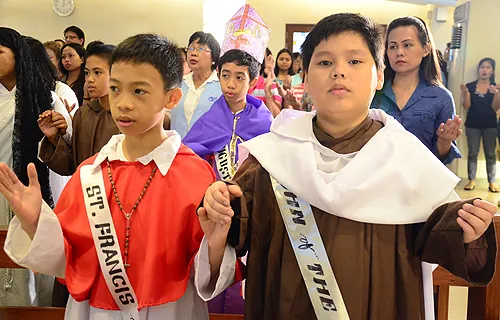
Manila, Philippines, Aug 5, 2021 / 04:02 am (CNA).
Catholic Church leaders in the Philippines signed documents with the Iglesia Filipina Independiente (IFI), or Philippine Independent Church, “for more ecumenical cooperation amidst diversity.”
In a joint statement signed on Aug. 3, leaders of both churches said that together they “ask and pray for mutual forgiveness for any injuries inflicted in the past.”
“We shall strive for the healing and purification of memories among our members,” read the statement released on the occasion of the 500th anniversary celebration of the arrival of Christianity in the country.
The IFI formally broke away from Rome and declared itself a nationalist church in 1902 “in the midst of a turbulent period of the Filipinos’ struggle for independence against the colonial rule of Spain and the United States,” the statement said.
The Philippines was under the control of Spain for 300 years until 1898 when the country declared its independence. The United States then ruled the country until 1945.
“The formation of the IFI was not against the Catholic Church, but rather against the continued domination of Spanish bishops and priests in the dioceses and parishes of the colony,” read the joint statement signed by leaders of the Philippine Catholic bishops’ conference and the IFI bishops.
“As part of a nationalist revolution, the creation of the IFI also signified a ‘religious revolution’ that appealed to the patriotic sentiments of the populace aspiring for the birth of a nation,” it added.
Since the American colonial period up to the present, Christianity in the Philippines has evolved with a variety of traditions, said the church leaders.
The IFI entered into a “Partnership Covenant” with the United Church of Christ in the Philippines and became one of the member-churches of the National Council of Churches in the Philippines, and the World Council of Churches.
It has also established concordats of full communion with the Episcopal churches and with several churches in the Anglican Communion, the Old Catholic Churches of the Union of Utrecht, and with the Church of Sweden.
The IFI has also accepted women in the ordained ministry of the Church.
The Catholic Church in the country has also grown with the appointment of numerous Filipino bishops together with the diminishing role of foreign missionaries. Through the years, the Church has opened its doors to ecumenical fellowship with other Christian churches.
The Second Plenary Council of the Philippines in 1991 has also endorsed the “true value of ecumenism … in the area of faith, justice, peace and development … for lay faithful, clergy and religious.”
This week’s joint statement also called for “mutual recognition of baptisms” between the IFI and the Catholic Church. The Trinitarian baptismal formula of the IFI has already been recognized by the Catholic Church in its list of validly administered baptisms by other Christian churches.
“We acknowledge this gift of Faith in God who is Father, Son and Holy Spirit, as expressed in the Apostles’ Creed and the Nicene Creed,” read the statement.
“We share the same Baptism, using the Trinitarian formula. This sacramental initiation incorporates us all in the one Body of Christ,” it added.
“Moreover, both churches manifest a strong devotion to the Blessed Virgin Mary, invoking her maternal intercession for all her children to come together and for upholding the dignity of women,” read the statement, which was signed by two Episcopalian bishops as witnesses.
The IFI entered into full communion with the Episcopal Church in 1961. In 1980, the Philippine Episcopal Church also affirmed in a signed agreement its mutual recognition of baptism with the Catholic Church.
Through the joint statement, both Churches urged the faithful through local communities in parishes, schools and seminaries “to forge these ecumenical ties of fellowship and common action.”
The Church leaders vowed that through “spiritual ecumenism,” they would encourage joint activities in prayer services, such as the celebration of the Week of Prayer for Christian Unity, Stations of the Cross during Lent and Holy Week processions and Scripture reading on Easter Sunday and other important feast days.
“Members of both churches can also join hands in social action ministries such as defending human rights and the dignity of the poor, migrants, women and children, and indigenous people; care for the environment; and peace building,” it added.
The IFI has 47 dioceses, including the Diocese of the Eastern and Western United States and Canada, with an estimated number of eight million members. It is led by a Supreme Bishop similar to a presiding bishop in other denominations.
The Church is the second-largest single Christian denomination in the Philippines after the Roman Catholic Church, comprising about 6.7 percent of the total population of the country.
If you value the news and views Catholic World Report provides, please consider donating to support our efforts. Your contribution will help us continue to make CWR available to all readers worldwide for free, without a subscription. Thank you for your generosity!
Click here for more information on donating to CWR. Click here to sign up for our newsletter.









Considering the times, if it were not reconciliation with an heretical movement might have prospect for future conversion of heretics. Unfortunately, and in consideration of the preeminence in the Philippine church of the progressive leanings of former Manila Archbishop now prefect Propaganda Fides Cardinal Luis Antonio Gokim Tagle that red flag warning pops up. Healing of memories cited in the document of reconciliation is tired New Age tripe [for interest the only time I enjoyed tripe was grilled with bacon at a NM matanza] that too often meant glossing over differences. I’m afraid Cardinal Tagle cited by Edward Pentin as a prominent papal candidate has a liking for ordinary tripe the less palatable kind favored by fellow Dicastery prefects Archbishop Vincenzo Paglia, Cardinal Kevin Farrell, perhaps the more abhorrent irregular fare communicated by special consultant to the Vatican Secretariat for Communications Fr James Martin SJ. Is the Philippines the next member with Germany of progressive visionary Cardinal Carlo Martini SJ’s updated Church?
My grammar isn’t world class. Considering the times, if it were not reconciliation with an heretical movement – is meant to say, Considering the times, if it were not these times, reconciliation etc.
As an American and a former resident of the Philippines for a number of years, it was my observation that many of the non-Catholic churches, Independent, Iglesia, Agalpyian, etc were centered on the self importance of their leaders and a desire to be separate from the Roman Catholic Church in order to satisfy their own agendas. While belief and practice are significant among Filipinos, theology is not so much. I doubt these “ecumenical” efforts will bear much fruit.